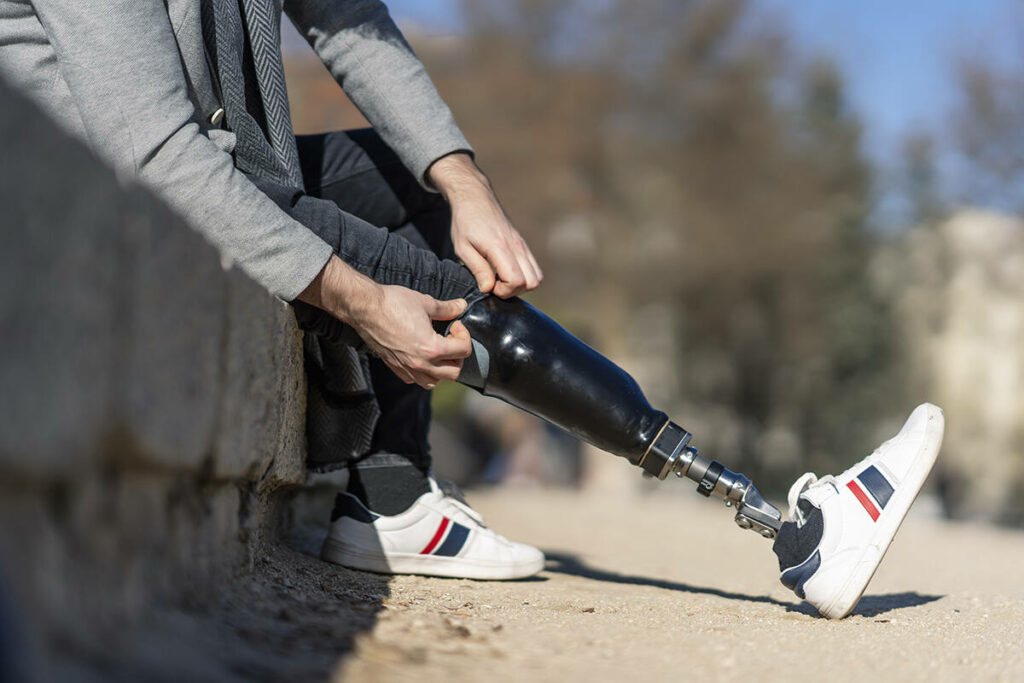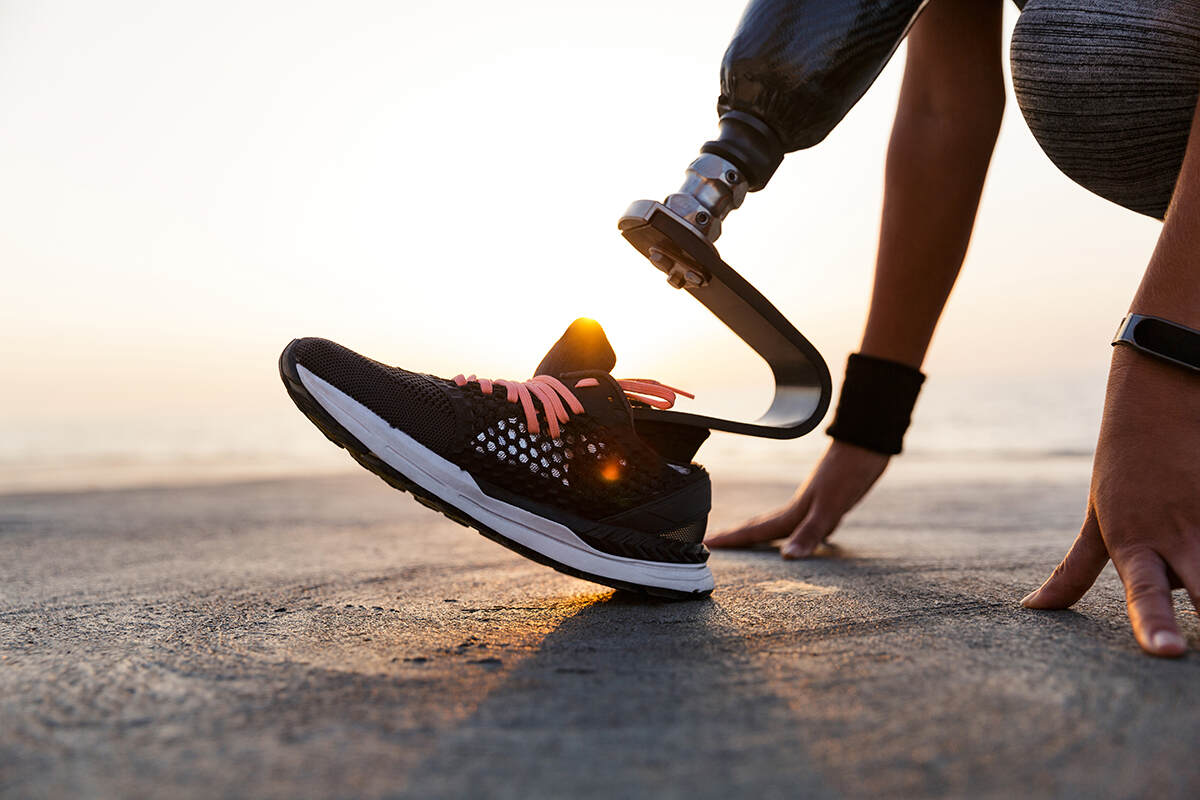Have you ever wondered how a perfect pair of boots for prosthetic legs can transform your walking experience with a prosthetic leg? It’s all about the right fit, support, and style. From ideal heel height to mastering the art of shoe shopping, we’re here to guide you on this journey.
Key Takeaways
- Finding the perfect fit, stability and style for prosthetic leg boots is achievable through proper sizing, customization options & adjustable heel heights.
- Try before you buy to ensure maximum comfort and functionality of your product!
Navigating Boot Selection for Prosthetic Legs
Finding the perfect footwear may feel like navigating a maze. But don’t worry, together we will traverse through the key areas of fit, stability, support, and style.
Let’s start with the cornerstone of any great right shoe – the fit.
Importance of Proper Fit
When it comes to amputees, the importance of a well-fitting boot cannot be overstated. Just like a tailored suit or a custom-made piece of jewelry, the perfect footwear should feel like a natural extension of yourself. A secure fit reduces pressure and friction on the residual limb, making walking or any other activity a breeze. Factors like:
- amputation level
- limb type
- posture
- shoe size
all play a part in finding the perfect fit.
How do you achieve it? It’s akin to solving a puzzle. You need to take into account your specific needs and preferences, accurately measure your foot size, and comprehend shoe sizing nuances. Remember, a boot that provides adequate support and stability, especially for those with a prosthetic knee, is a game-changer.
Stability and Support Features
Wearing boots with a wide toe box and semi-firm midsoles is akin to stepping onto a trampoline. You’ll experience the bounce-back, cushioning, and rigidity that matches the firmness of prosthetic ankles and feet, ensuring a secure and comfortable fit.
But that’s not all. Removable insoles, similar to the supportive heroes found in running shoes, distribute pressure evenly, absorb shock, and reduce the risk of instability or discomfort. These underappreciated elements of footwear significantly contribute to maintaining stability, directly enhancing comfort and reducing the energy consumption of walking for amputees.
Style Considerations
Who says comfort can’t be stylish? Imagine strutting your stuff in boots made from full-grain leather or genuine suede. From military boots to cowboy boots, there’s a wide variety of styles to suit different preferences and occasions, offering both style and practicality. The right style not only enhances your outfit but can also accommodate orthotics or prostheses more comfortably, significantly impacting your comfort levels.

Mastering Heel Height with Prosthetics
Let’s discuss an often-overlooked aspect – heel height. It’s not only about style, but also its impact on your prosthetic leg’s functionality. From flat shoes to high heels, we’ve got the low-down on how heel height can impact your overall comfort and body alignment.
Adjustable Heel Height
Think about the flexibility of wearing different types of shoes with varying heel heights. Exciting, isn’t it? That’s exactly what adjustable heel height in prosthetic feet offers. It’s comparable to having a secret tool that allows you to adapt to any footwear, enhancing your comfort and stability.
How does it work, you ask? Well, imagine a device with push buttons or pivot points that allows you to modify the height like adjusting the volume on your speakers. This ensures both comfort and proper alignment with your chosen footwear, making it a great innovation for users.
There are many different types of feet with adjustable heel height available, mostly for K2 and K3 users which means that it is possibly unsuitable for highly active individuals. But, for those that need the freedom to change shoes when desired or walk barefoot when needed an adjustable foot is the only choice!
Flat Shoes and Body Alignment
Conversely, we have flat shoes. They may seem like the straightforward choice, but they can considerably affect your body alignment. Studies have shown that shoe heel height can influence prosthetic alignment, walking comfort, and gait symmetry, especially for people with transtibial amputations.
However, it’s not just about choosing flat shoes. Proper arch support is also a key player in this game. Providing proper arch support can help:
- Reduce leg pain during activities
- Minimize skin problems
- Maintain normal limb rotation during walking.
The Quest for the Perfect Fit: Sizing and Modifications
Having discussed heel height, let’s proceed to another key aspect – sizing and modifications. After all, the magic of Cinderella’s glass slipper lies in its perfect fit, doesn’t it?
So, let’s delve into how you can measure your foot size accurately and explore the customization options offered.
Measuring Foot Size Accurately
Measuring your foot size is kind of like baking a cake. You need to follow the recipe (or steps, in this case) to get the desired outcome. And the result? A boot that fits like a glove. To accommodate volume changes in the residual limb, consider strategies like adding or removing stump socks, pads, or using custom bioimpedance analyzers to measure fluid volume changes in the limb.
But how do you measure your foot size accurately? It’s as simple as using a shoe measuring device or innovative shoe measuring devices available online. Walking around in the boots for a few minutes will also give you a clear idea of their comfort and support. Remember, a proper fit ensures maximum comfort, stability, and energy efficiency. Manufacturers can also give you the information about foot size but it is still a good idea to double check your foot size with the desired shoe.
Customization Options
Imagine having boots that are as unique as you are. That’s the beauty of customization. From flexible materials offering a soft and supple texture to contoured insoles providing additional support, there are plenty of ways to personalize your boots.
And the customization doesn’t stop there. You can choose from a variety of styles and sizes, and even accommodate prosthetic gel liners and sockets. It’s like having a tailor-made suit, but for your feet.
Specialized Boots for Different Activities
Let’s shift our focus to specialized boots designed for various activities. Whether you’re scaling a mountain or attending a formal event, the ideal pair of boots is out there for you.
Hiking Boots with Enhanced Traction
Embarking on a hike with a prosthetic leg is like venturing into a new world of possibilities. It all starts with the right pair of boots. Here are some features to look for in hiking boots for prosthetic leg users:
- Enhanced traction
- Midsole stability for better support
- Advanced cushioning technology to provide comfort and reduce impact
These features will help support your specific needs and make your hiking experience more enjoyable.
Choosing the right material for your hiking boots is also crucial. Leather or synthetic materials strike a perfect balance between being lightweight and offering sturdiness.
Dress Boots for Special Occasions
Let’s discuss dress boots. These are the boots you’d opt for a wedding, a party, or any event where you aim to present your best. They come with features like:
- reinforced fabric
- rigid and stable soles
- non-slip surfaces
- adjustable closures or zippers
These features make them even more accommodating for prosthetic legs and prosthetic limb users.
Dress boots are typically made from materials like:
- Leather
- Metal
- Wood
- Thermoplastic
- Synthetic fabrics
These materials not only enhance the look of the boots but also provide durability and functionality suitable for special occasions. Remember, it’s not just about looking good, but also feeling good.
One thing to keep in mind is that dress shoes in general does not offer the same cushioning as sneakers for example and can make it tougher to walk during the day. It is recommended when using shoes with a harder sole to not overuse and take short breaks when in need. And why not change in to something more comfortable when the party turns around to the dancefloor. It´s always a good idea to bring extra shoes!
The Significance of Sole Structure in Boots
Let’s acknowledge an often-overlooked element – the sole. The structure of a boot’s sole greatly contributes to comfort and functionality, making it a crucial component to consider.
Cushioning and Comfort
Step into a pair of boots with the right cushioning, and it’s like walking on clouds. The cushioning provides essential support, reduces pressure on the residual limb, and absorbs shock, making every step more comfortable.
Cushioning materials can range from leather and metal to wood, thermoplastic, rubber, foam, and silicone. Choosing the right type of cushioning can make a world of difference in your comfort levels.
Outsole Material and Traction
Imagine walking on a slippery floor with a pair of boots that have excellent traction. It’s like having your own personal safety net. The outsole material plays a significant role in enhancing stability and support, making it an essential part of a boot’s structure.
Prosthetic feet, including the prosthetic foot, can greatly benefit from the diverse selection of outsole materials offered by prosthetic boots, such as:
- Leather
- Neoprene
- Urethane foam
- Rubber
The right outsole material can provide excellent traction to prevent slipping and ensure maximum stability, minimizing the risk of falls and slips.
Shopping Smart: What to Look for in Retail Policies
Having covered all the essentials of selecting the perfect boots for prosthetic legs, let’s address the actual purchase process. From return policies to trying before buying, smart shopping involves understanding your options and making knowledge-based choices.
Great Return Policy
Shopping for boots can sometimes feel like a game of chance. But with a great return policy, you can engage in shoe shopping with peace of mind, knowing that if the boots don’t fit or meet your needs, you can simply return or exchange them. In this context, buying shoes becomes a worry-free experience.
Always look for favorable return policies, offering options for exchanges, refunds, and free return shipping. Since shoe sizes differ from different manufacturers consider buying more than one size.
Maybe one up and one down from what you are currently using ?
Trying Before Buying
Imagine ordering a car without a testdrive. Sounds risky, right? That’s why trying on boots before buying them can enhance your shopping experience. It gives you the chance to assess the fit, comfort, and functionality of the boots, ensuring that they provide the necessary support and accommodate your specific needs.
Some stores even go the extra mile by allowing you to purchase single shoes or create a pair with different sizes, which can be really good if you are a single sided leg amputee, not so much if you´re a bilateral 😉 . It’s all about finding the perfect fit for your prosthetic leg.
Frequently Asked Questions
Can you wear boots with a prosthetic leg?
You can wear boots with a prosthetic leg for increased traction and stability on slippery surfaces. Shoes or boots with rubber or neoprene composite soles offer better grip than leather or plastic.
What shoes are good for people with prosthetic legs?
Running shoes or sneakers are generally the best choice for people with prosthetic legs, allowing them to move comfortably and confidently.
Can you change the shoes on a prosthetic leg?
You can change the shoes on a prosthetic leg, just make sure to use a shoe with the same heel height as the original and wash your residual limb daily, or use a foot with adjustable heel height.
How much does a really good prosthetic leg cost?
A really good prosthetic leg can cost up to $70,000, providing a range of advanced features and capabilities.
How can I ensure a proper fit for my boots?
To ensure a proper fit for your boots, take into account your amputation level, artificial limb type, posture, and properly measure your shoe size.



